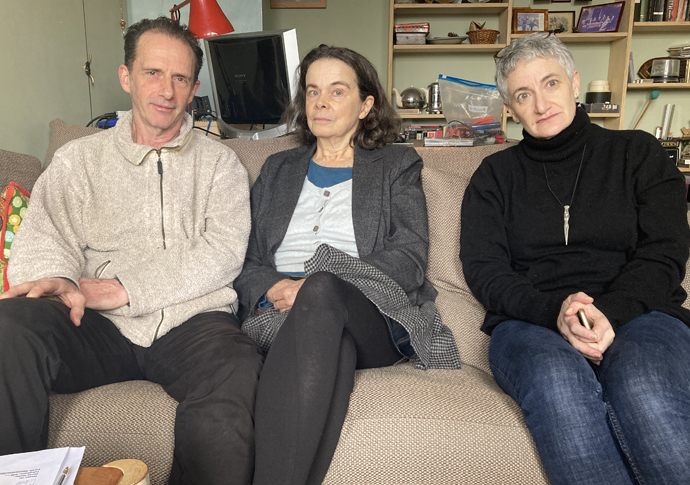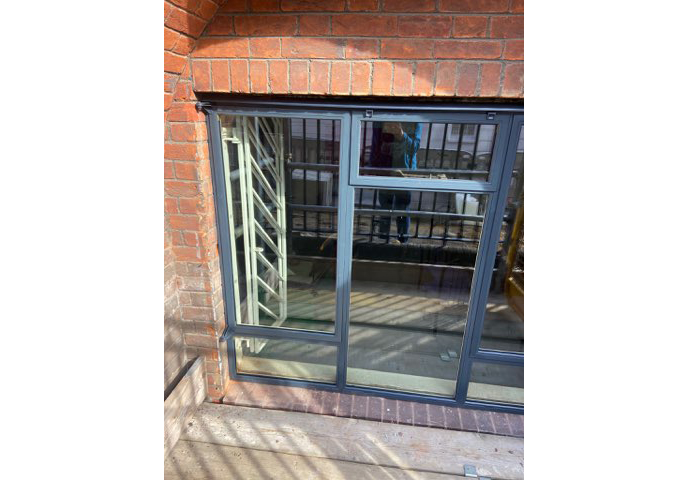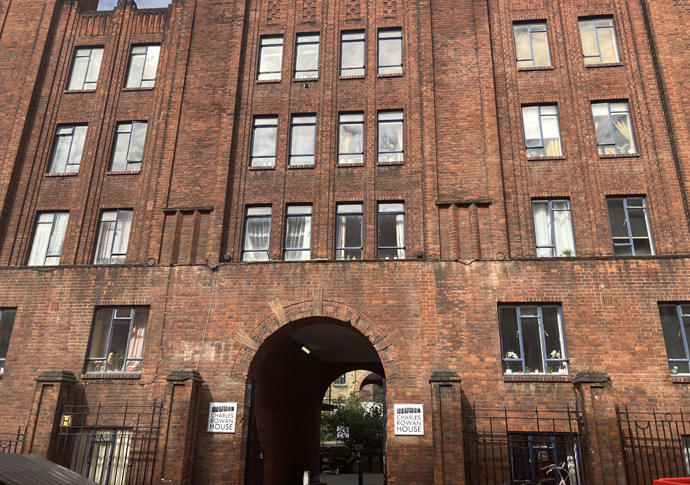Residents: ‘£41k bill for replacement windows means we’ll have to move’
Leaseholders in Grade II-listed homes are left open-mouthed by demand from Islington Council
Friday, 14th April 2023 — By Charlotte Chambers

Nick Burge, Janet Dowling Gormley and Kim Segel
WHAT would you spend four grand on? A seven-night luxury holiday to Barbados? A second-hand 4X4 Range Rover? Or replacing your home’s window with another that looks exactly the same as the old one, at a cost of £4,000 per window?
That’s the not-so-thrilling dilemma facing the leaseholders at a listed building in Clerkenwell – minus options one and two.
A letter sent to 39 leaseholders at Charles Rowan House in Margery Street in October, from their landlords, Islington Council, left them open-mouthed after it detailed how much it will cost them to replace the Crittall windows in their Grade II-listed homes, which were themselves 1960s replacement windows of the original Victorian ones.
Kim Segel, 55, who lives with her husband and two children, aged 12 and 15, in a three-bedroom home on the estate, has been quoted £41,000 to replace 10 windows.
The editor, who works part-time due to illness, criticised the council’s move as “tone deaf” in “the middle of our cost of living crisis” and added: “Finding £41k is like finding a second mortgage. My husband is a pensioner. It’s unaffordable. It’s absolutely unaffordable. What they’re doing to us, it’s like a second mortgage.”
She said their only option to pay for the windows would be to sell their home, while another neighbour, Nick Burge, 68, would have to spend the entirety of the money he has saved over his career – his pension – to pay for them.

A prototype of the replacement steel windows
Islington defended their choice of contractor, Vinci, with a spokesman explaining that while there was no bidding process specifically for the windows, it entered into “long-term partnering contracts with suppliers via a competitive tender process” in 2021 in order to gain “best value for money” for both the council and, “by extension,” its leaseholders.
Islington say the windows need replacing in order to install double glazing, and are putting in steel windows that would not need ongoing maintenance, but leaseholders say it is unnecessary in their homes as they have already installed secondary glazing.
Another neighbour, Janet Dowling Gormley, was told this month her hope of applying for a deed of variation – which would allow her to buy the freehold for all her windows for just £420 – had been rejected by Islington because the consultation period was over. She plans to challenge the decision and wants to go to the housing ombudsman.
She said: “We’re in a very difficult position – we’re going to have to sell up and move out of London. First of all £4,000 per window is very excessive, but I feel they haven’t been straight with us. I think they should allow us to apply for a deed of variation because we weren’t even informed about the existence of such an option – considering there was a consultation period and considering the price of window per flat it’s outrageous they haven’t told anyone.”
An Islington spokesman said: “Charles Rowan House is Grade II-listed building, meaning the design of notable features like the windows must not be altered, and replacements need to be like-for-like in terms of appearance in order to obtain listed building consent in the first place. The current windows are single-glazed Crittall units, which form a major part of the listed status of the building.
“A great deal of work has been undertaken with planners to agree a suitable replacement for these windows with a steel alternative. This alternative has now received listed building approval following the review of a pilot installation on site.
“An important benefit of the agreed steel window is that, unlike the existing units, they do not require cyclical redecoration.”
An Expressionist gem built for Met

Charles Rowan House – originally built to house Metropolitan Police officers
CHARLES Rowan House, located in Margery Street, Islington, was built from 1928-1930 and began its life as accommodation for married Metropolitan Police officers, writes Rebecca Robinson.
It was designed by the Met’s architect and surveyor, Gilbert MacKenzie Trench, perhaps most famous for designing the blue police box popularised by Doctor Who.
The building takes its name from Sir Charles Rowan, the first Metropolitan Police commissioner, appointed by home secretary Sir Robert Peel in 1829.
It was constructed in the Expressionist architecture style, which was unusual for the UK at the time.
It has since been recognised for its striking appearance and is Grade II-listed by Historic England for its architectural interest.
The red brick building consists of four large blocks, with a courtyard at its centre. Before it became a council estate in 1974, it was originally made up of 96 two- and three-bedroom flats across five floors, with a playground in the basement.
After Islington Council took it over, the building fell into disrepair and became so run-down that it was designated as a “hard to let” block with its own special housing list. However, since 2000, the courtyard has been relandscaped and the building improved under the Decent Homes Standard.
Now, the Charles Rowan House Tenants’ and Residents’ Association carry out gardening duties.